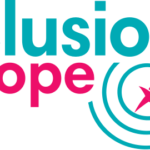Inclusion Europe produced three easy to understand videos about the European Disability Strategy and the role of the European Union in deinstitutionalisation.
European Disability Strategy
Persons with disabilities face considerable barriers in access to healthcare, education, employment, recreation activities, as well as participation in political life. The employment rate of people with disabilities stands at 50.8%, compared to 75% for people without disabilities and 28.4% of people with disabilities in the European Union are at risk of poverty or social exclusion. In March 2021, the European Commission adopted the Strategy for the Rights of Persons with Disabilities 2021-2030. The strategy called for an inclusive society in which the rights of people living with disabilities are protected and where there is no discrimination.
Read the easy-to-read transcript of the video about the European Disability Strategy.
Watch the easy to understand video about the European Disability Strategy.
Infographic – Elements and goals of the European Disability Strategy (1)
Deinstitutionalisation
The United Nations Convention on the Rights of Persons with Disabilities says that every person with disability has the right to live independently and to be included in community. Without independent living, persons with disabilities are unable to exercise many other Convention rights, such as education, work and employment, health or participation in political and public life. There are an estimated 87 million people with disabilities in the European Union of which 1,5 million still live in institutions. To end segregation of people with disabilities in institutions, there is a process called deinstitutionalisation which means supporting people to move out of institutions, to have their own home and support.
Deinstitutionalisation enables persons with disabilities to live independently, make their own decisions, be part of the community and, enjoy their rights as others. There are two ways to end institutionalisation. By establishing independent living and community-based services.
Read the easy-to-read transcript of the video about deinstitutionalisation.
Watch the easy to understand video about the deinstitutionalisation.
Deinstitutionalisation – Infographic (1)
Role of the European Union in deinstitutionalisation
The European Union has improved lives of many people with disabilities by helping to end segregation and institutionalisation. For example, with EU funds, the European Social Pillar, or the European Disability Rights Strategy. Independent living is central to the European Disability Strategy, which is EU’s main tool to implement the UN Convention. Likewise, it is central to the European Pillar of Social Rights, which promotes accessibility and independence in education, work, housing, as well as person-centred care. The EU’s directive on Work Life Balance, supports people who care for relatives with disabilities and the European Structural and Investment funds are a driving force in helping people out of institutions. For instance, by supporting community-based services. Inclusion Europe is member of The European Expert Group on the transition from institutional to community-based care, which is often called the EEG. The EEG makes reports, guidelines, and trainings about how to use public money to provide better support for people with disabilities. Despite all the work for deinstitutionalisation, the number of people in institutions in the EU has not changed over the past 10 years. People with intellectual disabilities and people with complex support needs are most likely to still live in institutions in many countries.
Read the easy-to-read transcript of the video about the role of the European Union in deinstitutionalisation.
Watch the easy to understand video about the role of the European Union in deinstitutionalisation.
Role of the European Union in deinstitutionalisation- Infographic





